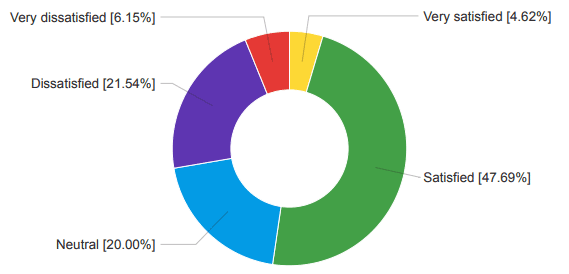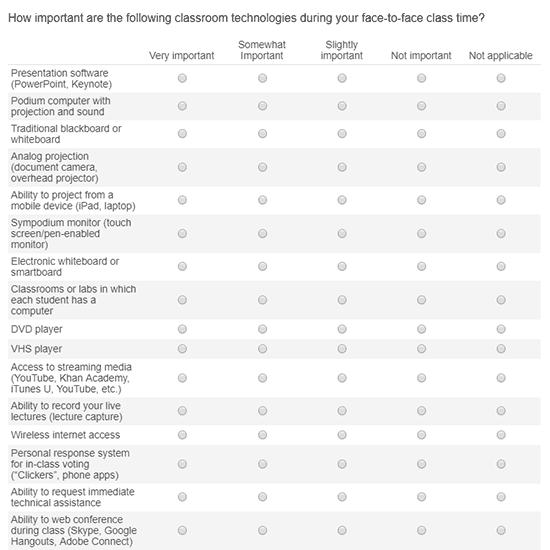Purpose
Establishing a baseline makes it possible to measure progress, particularly when success is determined by a subjective metric (like “user satisfaction”). That’s why it was important for my institution to survey all full- and part-time faculty before considering a campus-wide project to improve classroom technology.
The goals of our survey were to gauge:
- General satisfaction levels of faculty with current classroom technology
- The importance faculty placed on specific technologies
- How faculty in each school used technologies
- In-class policies set by faculty for student devices
Methods
With the help of a committee of engaged faculty, I built a 10-question survey. It was based on our goals (above) and fashioned from technology surveys I found online. The survey was built in Qualtrics and delivered via email by the dean of each school to faculty within their schools. (Ideally, I would have sent the survey from a single address, so that the response rate could be measured more accurately.) After two weeks, I closed the survey and reviewed the results.
Results: General Satisfaction Levels
While most faculty were generally satisfied with the classroom technology available to them, a significant number were frustrated. This metric provided the baseline I needed to broadly measure future, large-scale, classroom technology initiatives.

Results: Importance of Specific Technologies
Technologies were rated by faculty as follows:
- Most important: The availability of immediate technical assistance.
- Moderately important: Presentation software, projectors, and reliable teacher computer stations.
- Least important: VHS and “SMART” interactive displays.
These data helped to identify technology that we might consider phasing out, as well as where to spend our budget to get the best return for our money.
Results: Technology Use in Each School
Although the survey was anonymous, Qualtrics reported a large number of faculty abandoning the survey during a specific question: “In which school do you predominately teach?” This information would have been particularly helpful when deciding where to deploy new classroom technologies, but the question may have raised concerns in respondents that they were providing personally identifying data. Therefore, I would omit this question (and those like it) from any future anonymous surveys.
Results: In-Class Device Policies
The survey indicated that about 25% of faculty encouraged or required students to use smart devices during classes. Students without a smart device were often asked by faculty to share with another student. These results started a conversation about if we should make smart devices available to students on loan from the library, as a more equitable solution than requiring students to share.
Conclusions
From a survey like this, the data can focus an institution’s technology initiatives and can equip managers with tools to measure progress. Ultimately, this leads to better teaching and learning outcomes.

